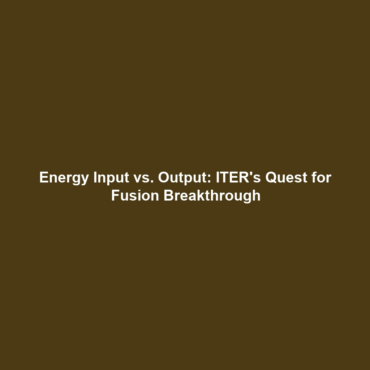Energy Input vs. Output: The Quest for Sustained Net Energy Gain in Fusion Energy
Introduction
The pursuit of sustainable and clean energy sources has propelled fusion energy to the forefront of scientific research. Understanding the energy input vs. output is vital, as advancements hinge on achieving a milestone where the energy produced by a fusion reactor surpasses the energy consumed to initiate the reaction. Current experiments, particularly the International Thermonuclear Experimental Reactor (ITER), aim to achieve this goal, yet no reactor has successfully accomplished sustained net energy gain. This article explores the significance of these development challenges within the broader context of fusion energy.
Key Concepts
Understanding Fusion Energy
Fusion energy is derived from the same process that powers the sun, which involves fusing light atomic nuclei, typically isotopes of hydrogen, to form helium while releasing considerable energy. The central concept of energy input versus output in this domain revolves around achieving a positive net energy result, essentially defined as:
- Energy Input: The total energy required to initiate and sustain the fusion reaction.
- Energy Output: The energy generated through fusion reactions.
ITER’s Role
The ITER project represents a significant international collaboration aimed at developing fusion as a viable energy source. Its design focuses on achieving thermal equilibrium, where energy output exceeds input over an extended duration, thus marking a pivotal step towards commercial fusion reactors.
Applications and Real-World Uses
The applications of achieving a successful energy input vs. output ratio extend beyond theoretical physics into practical implementations in fusion energy technologies:
- Power Generation: If successful, advanced fusion reactors could provide a near-limitless source of clean energy, significantly reducing dependence on fossil fuels.
- Space Exploration: Fusion technology could enable longer-term manned missions with minimal fuel requirements, dramatically altering space travel dynamics.
Current Challenges
Despite the promise of fusion energy, several challenges persist in achieving a positive energy balance:
- Technological Limitations: Current reactor designs struggle to maintain the extreme conditions necessary for sustained fusion reactions.
- Material Science Issues: Developing materials capable of enduring the harsh environments within fusion reactors remains a significant hurdle.
- Economic Viability: The high costs associated with building and maintaining ITER and similar facilities can deter investment into fusion research.
Future Research and Innovations
Looking ahead, ongoing research aims to surmount existing barriers, with potential breakthroughs on the horizon:
- Next-Generation Reactors: New reactor designs and technologies, such as smaller modular reactors, are being explored to improve efficiency.
- Advanced Plasma Control Techniques: Innovations in controlling plasma stability could lead to higher energy outputs.
- Alternative Fuel Sources: Research is ongoing into using alternative fuel cycles that may offer higher efficiency.
Conclusion
In summary, the investigation of energy input vs. output remains a cornerstone of advancing fusion energy. With projects like ITER paving the way for groundbreaking innovations, the scientific community is poised to tackle the challenges of achieving sustained net energy gain. Continued research and investment in this field could one day provide a clean and virtually inexhaustible energy source. For those interested in deeper insights, further reading on the latest in fusion research and ITER developments is highly recommended.

Leave a Reply